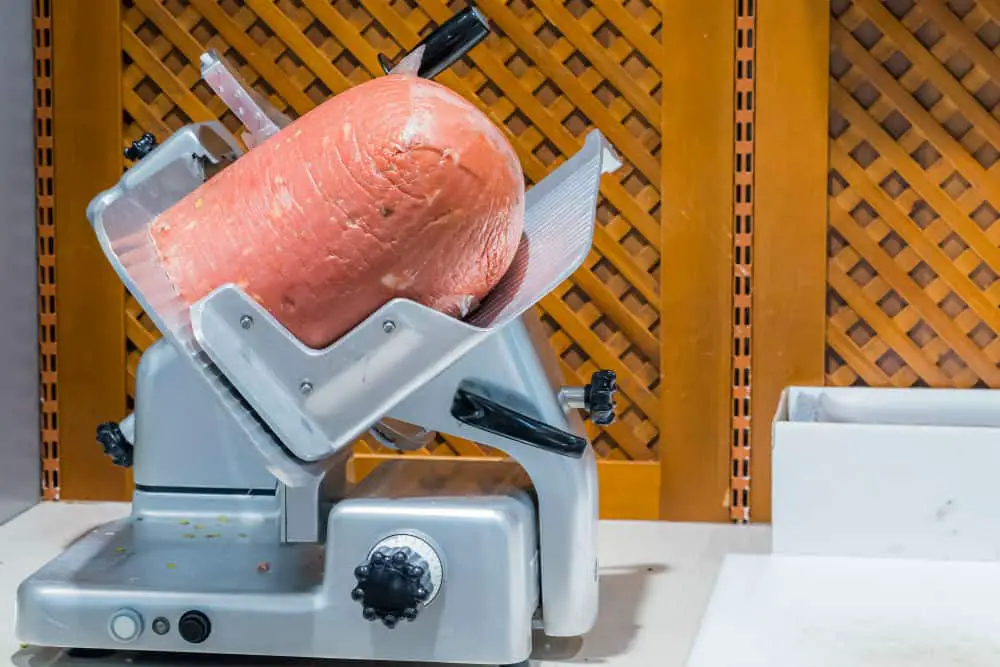This post contains affiliate links. As an Amazon Associate I earn from qualifying purchases
If you want to slice your own meat or cheese with a precision that rivals the finest delis, then you need a commercial or home use slicer for your food service operation. But before you buy something you don’t know its ins and outs, it is imperative you learn some of the meat slicer instructions beforehand in order to become the best chef.
Table of Contents
Slicer operation
Learning how to operate a slicer ensures you get the exact size of your slices without jeopardizing your safety. If you’ve never done this before, the following pointers will help you get started:
- Put the meat slicer on a strong and stable surface, preferably the kitchen countertop
- Ensure the power source provide the right voltage as needed by the slicer before plugging in
- Switch on the slicer and let it run for a few minutes just to be sure it’s working perfectly
- Turn the slice thickness regulator in a counterclockwise direction to obtain the correct cutting thickness
- Once you have the correct cutting thickness, push the fixing position right next to the plate
- Bring forward the meat carrier and push it back and forth over the blade using the pusher handle/delivery knob
- Once you are done slicing your meat, set the slicing thickness back to zero and turn the positioner back to its initial position. Basically, all the settings have to be set back to their original positions
- Switch off the slicer, unplug from the power source and fetch your sliced meat
- Clean the meat slicer and put it in a safe place
Things that define the best meat slicer
Before making a slicer purchase review the points below:
Blade
One of the first things you need to consider when buying a meat slicer is the cutting blade. Blades range in size from 8 to 14 inches.
The 8 and 9-inch blades are sufficient for light-duty cutting. For heavy-duty requirements, 12-14 inch blades are the best. These are good for all-round use as well.
You should also think about the type of material used to make the blade of the electric meat slicer. It’s best to look for a blade made from high carbon stainless steel.
This type of blade will resist stains and be easier to sharpen. This type of meat slicer will also have a sharper edge.
Strokes
You should also think about the type of strokes the meat slicer can have. Some models have different stroke lengths. Most meat slicers can slice with a 1/3, 1/2, or a full stroke.
Operating Mode
Slicers are available in both manual and automatic modes. With manual Slicers, you need to move the food back and forth to get it sliced.
Automatic slicers move the carriage with an electric motor, saving you time and labor. Manual Slicers, on the other hand, allow you to be involved in the end product more than with automatic units by having more hands-on work in the process. A high-quality manual slicer is also great to have as a backup when the electric version malfunctions or breaks down.
Carriage Size
On average, most meat slicers can hold products that measure 7-1/2 to 12 inches in diameter. So before you can slice any food item, make sure it can comfortably fit into the carriage slot. Also, the angle of the carriage really matters when it comes to ease of use.
For instance, a steeper carriage facilitates self-feeding more easily than a flat-lying one. The flat nature of the latter means manual pushing of food will be needed.
Slicers are usually placed near the sink area for easy washing or somewhere on the kitchen countertop or prep area. Slicers are not big appliances in themselves; however, make sure that they fit the prep area designated for them or that there is sufficient space on the kitchen countertop.
If you need more space or if you want to move the slicer from station to station, a slicer cart may be a good investment.
Speed
If you have an electric slicer in mind, then check out the speeds available. Most designs only have one speed. However, you can find an electric meat slicer that has multiple speeds. This type of slicer usually operates at speeds between 36 and 52 slices per minute.
Safety Features and Tips
Check whether there are easy to reach controls so you can stop the slicer quickly and cut guards/food pushers to protect your hands while slicing.
Your slicer can cause serious cut injuries when not properly used. Keep these safety tips in mind while using the slicer:
Keep meat properly in the slicer and ensure that the slicer is kept in proper position before you begin to cut
- Be careful not to reach across the blade
- After using, remember to turn off the slicer by setting the calibration back to zero
- Unplug the slicer before cleaning it
- Use cut-resistant gloves on both hands while cleaning the blade
Cleaning-up the meat slicer
If you slice meat and cheese with the same unit, you will want to thoroughly clean both the blades and the slicing table before switching foods. With the increasing number of milk and other food allergies, you run the risk of severely harming your customers or family members by not cleaning the unit when switching foods.
You’ll certainly appreciate a meat slicer that is simple to clean up. This means that the meat slicer you choose should have parts that are easy to wash in the sink or a dishwasher. Every part that needs to be cleaned should be easy to remove and easy to put back on.
The bottom line
Although there are many brands of commercial and home use meat slicers out there, not all of them will fit your requirements. You need to come up with a checklist of the important things you need in a meat slicer to avoid landing on an irrelevant or subpar product.
Ease of use, functionality and easy to clean are a few things that need to be prioritized. Above all, make sure the slicer you are about to buy is affordable and meets all the safety and sanitary regulations put forth by certified government authorities.


